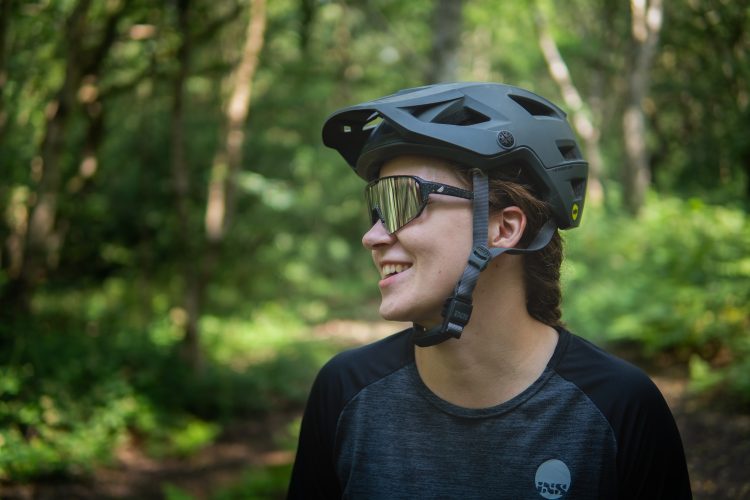
With many people getting into the long travel MTB market and really pushing themselves and their equipment to the limit, accidents are more and more likely to occur. Further, a head strike will probably ruin someone’s day. With this knowledge in mind, POC has really worked on rider safety.
Specs
The Cortex DH (MIPS) helmet is the extreme expression of POC’s commitment to rider safety. With not one but three certifications (EN-1077-B, EN-1078, and CPSC 12.03), the Cortex DH stands out. Unlike most helmets on the market, the MIPS version of the Cortex is two helmets in one. Literally: there are two distinct helmets, one inside the other.
As the illustration below demonstrates, on impact, you can see that the MIPS brain suffers much less stress.

The Cortex DH Mips has two shells and the outer shell is made from carbon, for its balance of strength and durability. Underneath that, the inner shell is made of a thin layer of structural polycarbonate (PC) with an expanded polypropylene (EPP) liner. The EPP liner allows for multiple impacts because, unlike EPS (expanded polystyrene), EPP expands back to shape after an impact. Add a thin Aramid fiber layer for further puncture resistance and you essentially have the workings of the Cortex.
Refinements in the chin bar allow for protection as well as breathability. The frontal opening is mesh covered, allowing air flow while still stopping bugs. Internally, the ear cavities are designed for maximum protection while still providing space for good hearing. The helmet’s shell mirrors this with cutouts and a felt-like material for minimal loss in hearing (great for hearing the whizzing of branches near your head). Another feature from POC is the second set of thinner cheek pads, for those who do not like a tight feel to their lid.
Fit

The POC features a snug, tapered fit (the opening being tighter than the rest of the helmet), which, in my opinion, is perfect. For one thing, it prevents the helmet from rocking back and forth or side to side, since on a long run that could get annoying.
While on the topic of fit, I stayed with the supplied cheek pads. For whatever reason, I feel more secure with them pressing against my face compared to a looser fit. I did not have a set of POC goggles to use at the time of the review, so I tried to use a pair of Giro’s (didn’t mesh well) and Oakley’s (worked fine). So if you already have goggles and are planning on purchasing the helmet only, bring your goggles along to check the fit.
Out on the Trail

As far as performance, this helmet does its job and works well as a protective device. Yes, I did eat dirt and yes, I did smack the ground with my face. But surprisingly, I did not hit hard enough to cause the MIPS to activate. I guess the side impact and Leatt brace helped prevent it.
Sharing my time with the Cortex and just one other helmet over the summer, you would expect things to get stinky. Surprisingly enough, the Polygiene liner worked very well at inhibiting bacteria-associated odors. There’s nothing worse than dunking your head into a helmet that smells like a hockey locker room.
I do have a couple of things to gripe about: this helmet runs hot. The dual layers are supposedly designed to breath. Breath they do, but not very much. So yes, it gets hot. If you’re constantly on the move descending there is little issue, but get caught in tight, technical sections where speed is not an option and the temperature in the Cortex starts to warm up quicker than all the other brands I have tested to date.
The eye opening, although large, does limit some goggles from fitting properly. The lack of a molded relief on the sides and back of the helmet means you need a goggle strap with silicon to prevent strap movement (this can’t be helped due to the importance of a smooth inner surface for the inner liner).
Bottom Line
Overall, the Cortex DH is definitely a well thought-out helmet with safety at the forefront of its design. Other than those two small issues, I found that I rather liked the Cortex DH and do feel safer in this unit compared to other helmets. With an MSRP of $500, that safety does not come cheap. But how much does it cost for a week’s stay in an ICU?
A big thanks to the folks at POC for sending down the Cortex DH for review.




















0 Comments